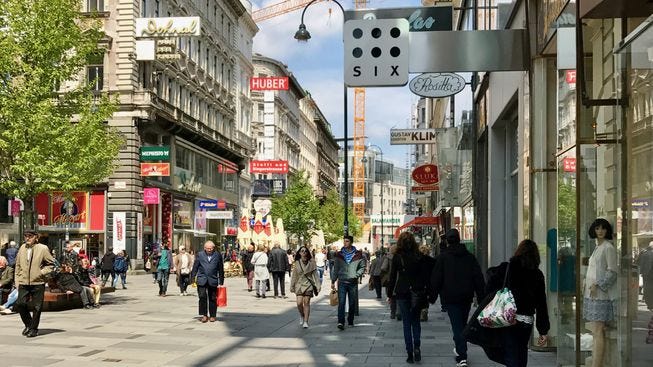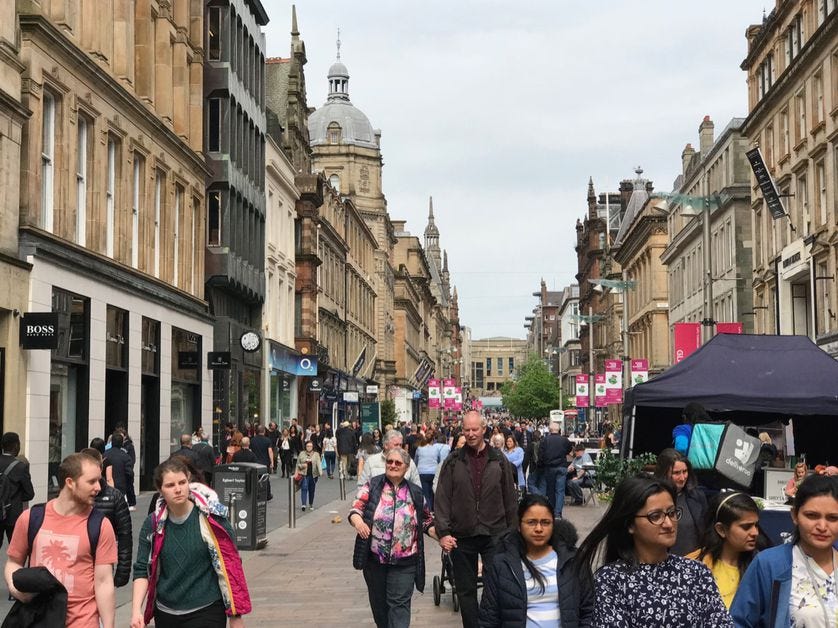From the archives: Why aging boomers need walkable cities more than convenient parking
Most people will live about seven to ten years beyond their ability to safely drive. How will they get around?
On my birthday, I looked into my archives for posts I had written about cities and getting older. This one from 2021 is particularly relevant for Ontario, Canada, where the Premier is planning to rip out the bike lanes that make the roads safer for so many older riders like me.
The Guardian has been running a fascinating series called Walking the City, and North American cities don't come off looking very good. In Denver, people ask "What's wrong with the sidewalks? Why is it so hard to walk here?" In San Francisco, an artist installs much-needed benches and they "attract homeless people, and criticism." I was interviewed by The Guardian about Vision Zero initiatives, which involve slowing down cars and redesigning streets. I complained that nobody is willing to make street safer for walking:
The fundamental issue in America is that almost anywhere they try to implement Vision Zero, almost everyone in those cities drives. They aren’t willing to be slowed down, they object, and the politicians refuse to do anything that's going to make drivers angry.
Many of those angry drivers are older people, who complain when sidewalks are widened or bike lanes are installed because they have to drive to the doctor or to go shopping. In fact, older people have become a political football in planning circles; Michael Lewyn writes in Planetizen:
Urbanists old and new argue that as our population ages, more people will be unable to drive, and thus will need better sidewalks and more public transit. On the other hand, defenders of the status quo argue that seniors walk more slowly than everyone else, and thus are more likely to need cars and taxicabs.
But looking at the data, Lewyn found that a smaller proportion of over-65s drive than in any other age group. He looked at cities around the United States and found that in New York's Manhattan borough, 78 percent of over-65s live car-free. Of course, New York is a famously walkable aberration, and it has issues. Take 67-year-old Fran Lebowitz, who writes in the Guardian,
"I've never taken a walk just to walk. People who drive everywhere 'take a walk,' but for me it's a form of transportation." ...
"Walking used to be a kind of pleasure, but it is really an enormous effort to make your way around town on foot. The bicycles everywhere, the tourists everywhere, some tourists on bicycles – the worst possible combination. I feel like I'm in The Exorcist, my head twirling around to see what way they'e coming from."
In other cities, over-65s generally have the lowest percentage of drivers of any age group. According to Lewyn:
In Pittsburgh, only 20 percent of 35-64 households, 22 percent of under-35 households, and 31 percent of over-65 households are car-free. Similarly, in Philadelphia 27 percent of 35-64 households, 32 percent of millennial households, and 37 percent of over-65 households are car-free. In these cities, seniors are actually the least likely to own cars... The national pattern is similar: in the United States generally, 12 percent of over-65 households have no car, while 9 percent of under-35 households have no car.
Lewyn uses these statistics to question the accepted wisdom. Almost everywhere he looked, "seniors are less likely to own cars than millennials or the middle-aged. I found no city where seniors are the most car-owning age group — a fact that seems to me to discredit the 'seniors need cars' narrative."
There are a lot of holes in his arguments, the major one being that over-65s are a very big group covering a lot of people who are healthy and walk or drive perfectly well, and a lot of very old people who cannot drive at all. But the core of the planning issue is all about a subset — those who can drive but due to disability of some kind, cannot walk very far.
There is no question that people with disabilities who can drive should be accommodated. But when one looks at the health benefits that come from walking, it's pretty clear that wider sidewalks and bike lanes (which actually make sidewalks safer) are better for people of every generation.
One British study found "significant associations between the increased walkability of a neighbourhood, lower blood pressure and reduced hypertension risk among its residents," particularly those over 50 years old. The doctor doing the study told the Guardian:
We are spending billions of pounds in preventing and curing cardiovascular diseases — if we are able to invest in creating healthy cities through small retrofits in the design of our neighbourhoods to make them more activity-friendly and walkable, then probably, we will have significant savings in future healthcare expenditures.
And, as mentioned in an earlier post, we have a moving target with the 75 million aging baby boomers, the vast majority of whom live in the suburbs and the oldest of whom have just turned 70. Most are still driving, and when you ask those suburban drivers what they want now, it's more lanes and more parking and get rid of those damn bikes.
But in 10 or 15 years, it will be a different story, and all those slow-walking aging boomers will want those bump-outs, the slower traffic, the safer intersections that a real Vision Zero delivers. Instead of using seniors as a political football, we should be keeping our eye on the longer game.





As a senior -75- i know i am probably facing a no driving life in the next couple of years. Because i also have a inability to carry even small amounts of groceries, i have started having my groceries delivered and i do most of my shopping online. The comment about walking being form of exercise vs transportation struck home. I too used to walk to go somewhere; now it is for exercise and in the winter on my treadmill. Where i live in my small city shopping is slowly being regulated to malls which of course, are not in my neighbourhood.
I want to be a participant in the bikelane an walkable city but at this stage of life, it is getting more and more abstract. Ut at least i am keeping my csr off the roads.
As one of the oldsters who is beginning to have physical difficulty getting around on my feet - I want to see good personalised transport; I prefer a taxi to rideshare like Uber, if I can't drive (that's going to come). Walking is a problem already, and our bus service is a product of Calgary's sprawl and prolific car ownership. A good bike-lane system, to keep the cars separated from the bikes and the bikes separated from the pedestrians would be a distinct benefit. One of the issues here is pedestrians who stray into designated bike paths.
One of the reasons why the elderly drive less could be because (in Alberta) you have to get a doctor's certificate after 80, repeated at increasingly shorter intervals. First, find a doctor!